
Photo from wikipedia
High amounts of aerial pollutants like dust and microorganisms can pose serious health hazards to animals and humans. The aim of the current study therefore was, to assess the efficiency… Click to show full abstract
High amounts of aerial pollutants like dust and microorganisms can pose serious health hazards to animals and humans. The aim of the current study therefore was, to assess the efficiency of UVC irradiation combined to air filtration in reducing airborne microorganisms at laboratory scale. In a second part, a UVC-combined recirculating air filtration module (UVC module) was implemented in a small animal facility in order to assess its improvement of air quality with regard to airborne bacteria and dust. Tests at laboratory scale were performed using aerosols of Staphylococcus (S.) aureus, Actinobacillus pleuropneumoniae, porcine parvovirus (PPV) and porcine reproductive and respiratory syndrome virus. We varied relative humidity (RH) to evaluate its effect on UVC irradiation efficiency. In addition, viability of pathogens inside the filter material was determined over up to six months. UVC-combined air filtration resulted in a more than 99% reduction of viral and bacterial particles. RH had no influence on UVC efficiency. Viability in the filter matter varied depending on the pathogen used and RH with S. aureus and PPV being most resistant. In our small pig facility consisting of two separated barns, weekly air measurements were conducted over a period of 13 weeks (10 piglets) and 16 weeks (11 piglets), respectively. Airborne bacterial numbers were significantly lower in the barn equipped with the UVC module compared to the reference barn. On average a reduction to 37% of reference values could be achieved for bacteria, whereas the amount of total dust was reduced to a much lesser extent (i.e. to 78% of reference values). Measures taken in front of and behind the UVC module revealed a reduction of 99.4% for airborne bacteria and 95.0% for total dust. To conclude, recirculating air filtration combined to UVC provided efficient reduction of pathogens at laboratory and experimental scale. The implementation of such devices might improve the overall environmental quality in animal facilities.
Journal Title: PLoS ONE
Year Published: 2019
Link to full text (if available)
Share on Social Media: Sign Up to like & get
recommendations!